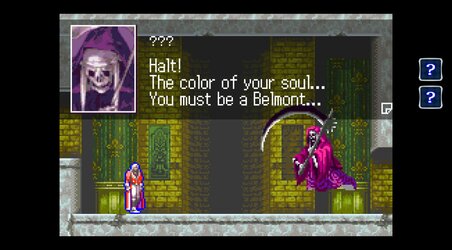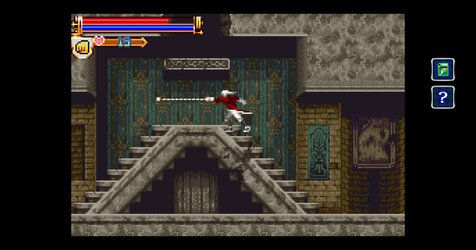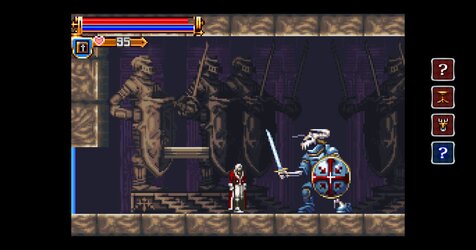- Joined
- Jun 27, 2014
Some happier news.
Recently, I've been on a bit of an oldschool CV kick because I've played basically every Castlevania game at some point or another and I figured "fuck it, we ball" with the Advance collection, which has a bunch of titles I was a fan of but seemingly can't find amidst my dozens of backups now, strangely enough. All in all, a great time, especially if you want to play these games on a modern platform with some nice extras bundled in for spice.
However, whilst fucking around wtih them, I realized that the new system the games run in is basically a fancy way of getting the ROMs to work, and that gave me an idea:
Could I do what I did in FF1 and fuck around with the game knowing this, when I changed the character sprites and text to the classic versions from FF Origins?
In short, pretty much. The actual practical way of doing this took a lot more work, because the actual ROM files (and there's twelve of the fucking things) are hidden away, compressed within the game files, so you have to decompile them in order to run a proper ROM patch on each one individually, but to my delight, I was able to get the visual overhaul mod for Harmony of Dissonance working.


All it really does is swap the palettes around to be more muted and remove the blue border on Juste, but the actual results in-game make the game look substantially better, and it's nice to see this particularly undersung title get some love.

In theory, you could get damn near any Romhack to work with the collections, and that's kind of amazing.
Recently, I've been on a bit of an oldschool CV kick because I've played basically every Castlevania game at some point or another and I figured "fuck it, we ball" with the Advance collection, which has a bunch of titles I was a fan of but seemingly can't find amidst my dozens of backups now, strangely enough. All in all, a great time, especially if you want to play these games on a modern platform with some nice extras bundled in for spice.
However, whilst fucking around wtih them, I realized that the new system the games run in is basically a fancy way of getting the ROMs to work, and that gave me an idea:
Could I do what I did in FF1 and fuck around with the game knowing this, when I changed the character sprites and text to the classic versions from FF Origins?
In short, pretty much. The actual practical way of doing this took a lot more work, because the actual ROM files (and there's twelve of the fucking things) are hidden away, compressed within the game files, so you have to decompile them in order to run a proper ROM patch on each one individually, but to my delight, I was able to get the visual overhaul mod for Harmony of Dissonance working.


All it really does is swap the palettes around to be more muted and remove the blue border on Juste, but the actual results in-game make the game look substantially better, and it's nice to see this particularly undersung title get some love.

In theory, you could get damn near any Romhack to work with the collections, and that's kind of amazing.
For those who aren't as familiar, Dissonance is a bit of an odd duck because of its development, which left it with a number of oddities that aren't really present in other Castlevania games at the time. The Game Boy Advance was ostensibly a 32-bit system, but its architecture wasn't like the PS1 or Saturn, and it had significantly less storage space. Because of this, developers worked very hard at milking every last drop of performance out of the hardware at the time. It entered development during the end-point of Circle of the Moon's development a and had a completely different team working on it.
Circle had one constantly complained-about problem: While a good game, the console it was on was not backlit, and as a result, it was fucking notoriously hard-to-see. Circle also cheated a bit to save space - constant asset re-use, very limited animation sets (very few things in the game have more than three frames total), and a lack of major effects the series was fond of at this point (like rotational effects or scrolling skylines) kept down storage space, which Circle used to provide samples for the audio, giving it particularly high-quality music for the time. When you play it on a handheld, you mostly won't notice the various tricks it pulled to save space, but you absolutely will on a big screen of any kind.
Dissonance wanted to first address the problems of circle: Bigger sprites, better animation, clearer visuals on GBA, and all sorts of visual tricks and such that they had in other CV games at the time. And it has all of these. However, it came at two costs: saturated colors and file size, and the methods that would be use to allow better file compression and better storage by the time Aria of Sorrow came out didn't exist just yet. To get around this, they used FM with very limited range, resulting in Dissonance having a distinctly crunchy soundtrack that called to mind more NES titles than the full-fledged scores of Circle.
A lot of its problems are solely products of the time it was released in and the development cycle behind it, and it's considered something of an anomaly, since it's situated right between its more successful siblings (Circle and Aria), but there is a lot to enjoy here if you give it a chance.
Circle had one constantly complained-about problem: While a good game, the console it was on was not backlit, and as a result, it was fucking notoriously hard-to-see. Circle also cheated a bit to save space - constant asset re-use, very limited animation sets (very few things in the game have more than three frames total), and a lack of major effects the series was fond of at this point (like rotational effects or scrolling skylines) kept down storage space, which Circle used to provide samples for the audio, giving it particularly high-quality music for the time. When you play it on a handheld, you mostly won't notice the various tricks it pulled to save space, but you absolutely will on a big screen of any kind.
Dissonance wanted to first address the problems of circle: Bigger sprites, better animation, clearer visuals on GBA, and all sorts of visual tricks and such that they had in other CV games at the time. And it has all of these. However, it came at two costs: saturated colors and file size, and the methods that would be use to allow better file compression and better storage by the time Aria of Sorrow came out didn't exist just yet. To get around this, they used FM with very limited range, resulting in Dissonance having a distinctly crunchy soundtrack that called to mind more NES titles than the full-fledged scores of Circle.
A lot of its problems are solely products of the time it was released in and the development cycle behind it, and it's considered something of an anomaly, since it's situated right between its more successful siblings (Circle and Aria), but there is a lot to enjoy here if you give it a chance.

